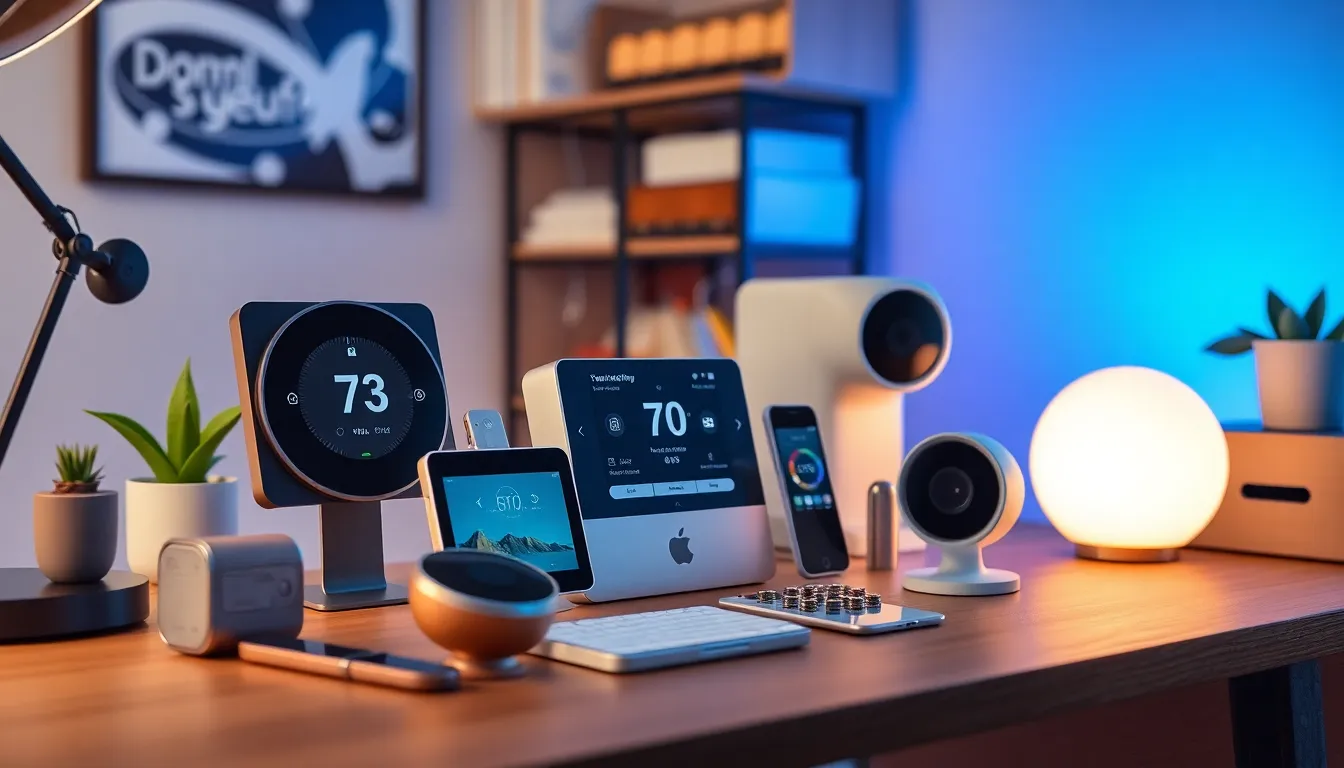Table of Contents
ToggleImagine a world where your toaster knows just how brown you like your bread and your fridge nudges you with reminders to buy milk. Welcome to the Internet of Things (IoT), where everyday objects become smart and sassy. With IoT, mundane tasks transform into seamless experiences that make life feel like a sci-fi movie—minus the flying cars and rogue robots, of course.
Overview of Internet of Things (IoT)
The Internet of Things (IoT) connects various devices to the internet, allowing seamless communication and interaction. Smart devices, including thermostats, security systems, and wearables, collect and exchange data to enhance user experiences. Sensors embedded in these devices monitor environments, enabling real-time adjustments for efficiency and convenience.
Manufacturers have embraced IoT technology, focusing on automation and remote control. Home automation systems let users manage lighting, temperature, and security from smartphones, transforming homes into smart living spaces. More industries are integrating IoT solutions to streamline operations, with applications ranging from supply chain management to agriculture.
Data plays a crucial role, driving analytics for improved decision-making. Businesses can analyze patterns and trends, optimizing processes based on real-time data insights. This analytical power boosts productivity and enhances customer satisfaction.
Security concerns accompany IoT advancements, as connected devices may expose networks to vulnerabilities. Manufacturers prioritize security features, implementing encryption and authentication processes to protect user data. Regular software updates help address emerging threats.
Governments recognize the potential of IoT in smart city initiatives. By leveraging interconnected devices, cities can improve traffic management, waste collection, and energy usage. These developments pave the way for sustainable urban living.
Overall, IoT represents a transformative force, reshaping how individuals and industries interact with technology. The integration of intelligent devices leads to more efficient, automated, and responsive environments, illustrating the future of connectivity.
Key Components of IoT

The Internet of Things (IoT) consists of several key components that contribute to its functionality and effectiveness.
Sensors and Devices
Devices serve as the backbone of IoT systems. Sensors collect data from the environment such as temperature, motion, and light levels. They transmit information to interconnected systems for analysis. Examples include smart thermostats, wearables, and security cameras. Advanced sensors can even monitor vital health information. Such capabilities enhance user convenience and efficiency across various applications.
Connectivity
Connectivity forms the foundation of IoT networks. Various communication protocols facilitate device interaction over the internet. Common methods include Wi-Fi, Bluetooth, and cellular networks. Each protocol offers unique advantages depending on the use case. For instance, Wi-Fi provides high-speed connectivity, while Bluetooth excels in low-power consumption. A seamless connection ensures data flows smoothly between devices and users.
Data Processing
Data processing enables meaningful insights from collected information. Systems analyze the data to derive trends and patterns, facilitating informed decision-making. Techniques vary from edge computing for immediate analysis to cloud processing for extensive data sets. Platforms utilize machine learning algorithms to improve accuracy over time. Effective data processing maximizes operational efficiency and enhances user experiences.
Applications of IoT
The Internet of Things (IoT) has numerous applications across various fields. Smart devices transform everyday tasks by enhancing convenience and efficiency.
Smart Homes
Smart homes incorporate IoT technology to create a connected living environment. Home automation systems allow users to control lighting, heating, and security remotely. Smart thermostats optimize energy usage by learning habits and preferences. Security cameras provide real-time monitoring, ensuring homeowners feel safe. Voice-activated assistants simplify daily tasks through hands-free operation. These innovations contribute to a more interactive, energy-efficient lifestyle.
Healthcare
Healthcare benefits significantly from IoT advancements. Wearable devices, such as fitness trackers and smartwatches, monitor patients’ vital signs continuously. Data collected from these devices enables healthcare professionals to offer personalized care. Remote monitoring systems facilitate timely intervention for chronic conditions. Additionally, smart medication dispensers ensure patients adhere to their prescriptions. This integration of technology improves patient outcomes and enhances overall healthcare delivery.
Industrial IoT
Industrial IoT revolutionizes manufacturing processes by introducing smart machinery and real-time data analytics. Connected sensors monitor equipment performance, enabling predictive maintenance. This reduces downtime and prolongs machinery life. Supply chain efficiencies improve through real-time tracking of materials and inventory levels. Additionally, automation enhances productivity by streamlining workflows in factories. Industries utilizing IoT experience significant cost savings and increase operational efficiency.
Challenges and Concerns
The Internet of Things (IoT) introduces several challenges and concerns that impact users and industries alike.
Security Issues
Security issues represent a significant concern in IoT deployment. Connected devices create numerous entry points for cyberattacks, exposing networks to potential threats. Common vulnerabilities include inadequate authentication protocols and unencrypted data transmissions. Data breaches can lead to unauthorized access to sensitive information, resulting in financial losses and reputational damage. Manufacturers must implement robust security measures, including end-to-end encryption and regular patch updates. A proactive approach to security can mitigate risks and enhance user trust in IoT applications.
Privacy Concerns
Privacy concerns further complicate IoT integration. The extensive data collection performed by smart devices raises questions about user consent and data ownership. Personal information, including location and behavioral patterns, can be harvested without explicit permission. Users often remain unaware of how their data is used or shared among third parties. Stricter regulations, such as the General Data Protection Regulation (GDPR), guide data usage practices. Ensuring transparency in data handling and user rights can help address these privacy issues and foster a secure environment for IoT adoption.
Future of IoT
Innovation in IoT continues to evolve, promising even greater integration in daily life. Experts foresee advancements in machine learning and artificial intelligence, enhancing the capabilities of connected devices. Automated home systems might soon adapt to user preferences, creating a tailored living experience.
In transportation, connected vehicles are likely to revolutionize how people commute. These smart vehicles can communicate with traffic management systems, reducing congestion and optimizing routes. Public transportation could become more efficient with real-time data from connected vehicles, making commuting easier for passengers.
Healthcare’s future also hinges on IoT, with remote monitoring becoming mainstream. Devices that track health metrics allow for proactive care and streamlined communication between patients and healthcare providers. Wearables will gather vital data, enabling early intervention for chronic illnesses.
Industry applications are set to expand, paving the way for smart factories. IoT technology will drive predictive maintenance, reducing equipment downtime and improving production efficiency. Real-time data analytics will ensure better inventory management and supply chain optimization across sectors.
Environmentally, IoT will contribute to sustainable practices. Smart grids will enhance energy efficiency, allowing users to monitor consumption in real time. Agricultural IoT sensors can optimize water usage and crop management, promoting sustainable farming methods.
Security tends to become a focal point as IoT connects more devices. Manufacturers must address vulnerabilities by implementing robust security measures. Ensuring user privacy and data protection will foster trust, encouraging broader adoption.
IoT’s future holds immense potential across various sectors, emphasizing efficiency and data-driven decision-making. Connectivity and innovation will drive it forward, shaping a digitally integrated world.
The Internet of Things is revolutionizing everyday life by transforming ordinary objects into smart devices that enhance convenience and efficiency. As IoT technology continues to evolve, it’s clear that its applications span numerous industries, from healthcare to smart cities.
While the benefits are substantial, challenges such as security and privacy must be addressed to ensure safe adoption. Manufacturers and users alike must prioritize robust security measures and transparency to foster trust in this interconnected world.
Looking ahead, the potential for IoT to drive innovation and improve quality of life remains vast, paving the way for a future where technology seamlessly integrates into daily experiences.







